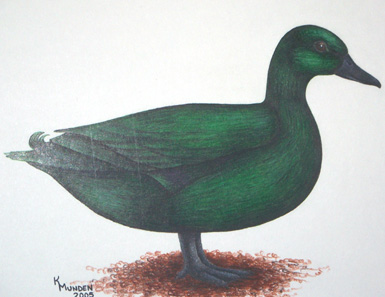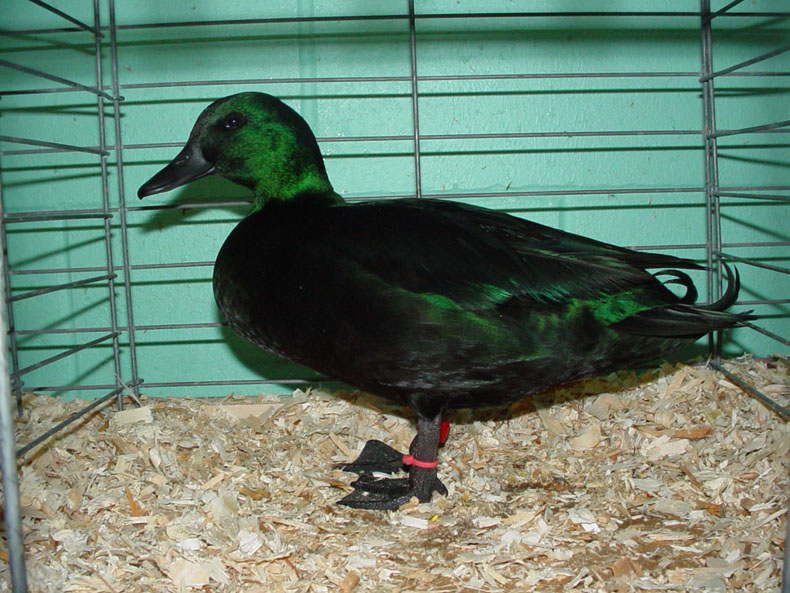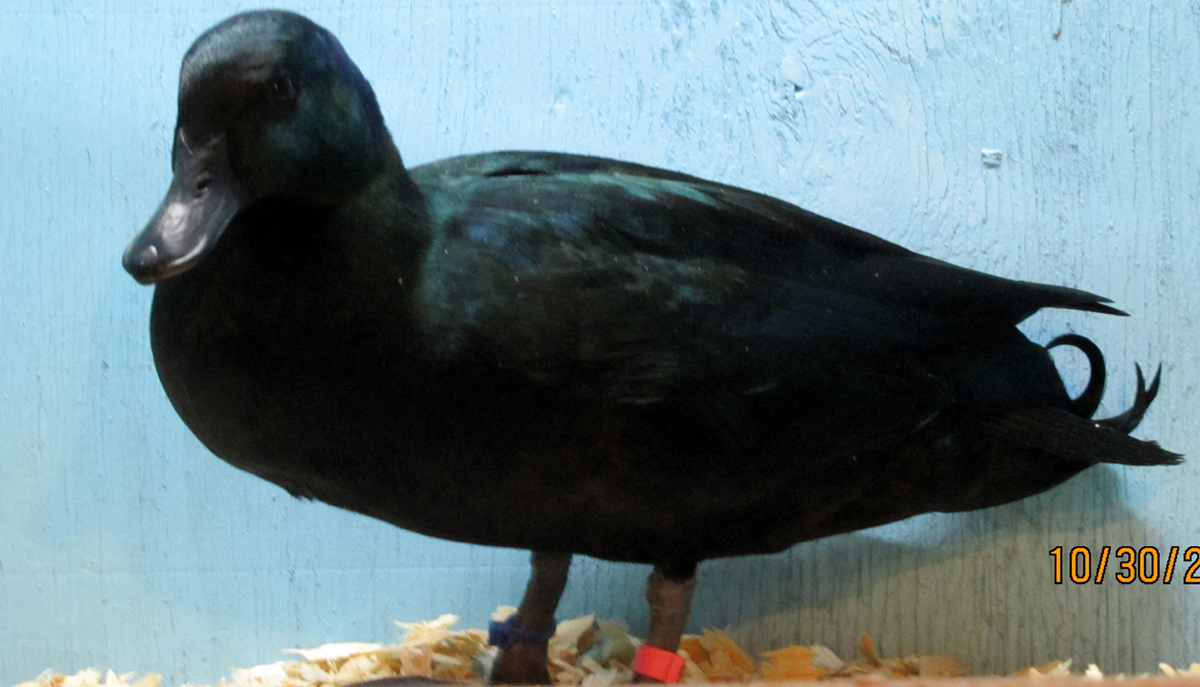 |

|
Currently there are no events or updates to display. |

Evaluating the Black East Indie in the Showroom
Evaluating the Black East Indie in the Showroom
In my experience, the judging of the Black East Indie is easily the most inconsistent of the breeds in the bantam duck class. Most judges who have any expertise in bantam ducks can now pick a good Call although they may get lost when asked to judge a deep class and many still have trouble with the parti colored ducks which is why the Whites probably win more often than they should. Since show quality Mallards are seldom shown outside of places like California and Minnesota, many judges lack the opportunity to see classes of Mallards with a range of quality in them. Unfortunately, the Mandarin is seldom seen at all in shows today. The Indie, on the other hand, is both plentiful at shows and presents a type which many judges find hard to understand. Perhaps the most common mistake judges make is assuming that Indie type should be close to that of the Mallard so Indies with flat underlines, long legs, and a flat top line to the head are sometimes placed up in classes. What they are placing is, in type, closer to a black Mallard than an authentic East Indie. It is usually easiest to understand and to evaluate breed types which are on the extreme ends of the spectrum: the Mallard’s long, narrow body or the Call’s short, cobby body are good examples. The body type of the East Indie fits in between those extremes and as such is more difficult to describe and to measure. Perhaps, it makes sense to use the body types of the Call and Mallard to contrast with the East Indie. For example, the Mallard should have no crown at all on its head while the Call should have an exaggerated crown which contributes to a head often described as round in shape. The East Indie should have an oval head, which means that there should be some rise but not an extreme one. Be aware that in both the Call and the Indie, the bird possesses the ability to flatten it's crown somewhat when it is startled or afraid. The bill length of the three breeds provides another interesting comparison. The Mallard’s bill should be quite long and relatively narrow. Especially in males, one may see bills measuring three inches. One added feature of the Mallard's bill that should not be present in any other breed of duck is a somewhat concave appearance to the topline of the bill. In any other breed of duck, such concavity is called a “dished bill”- a disqualification. The Call's bill should be very short and very wide. A good Call bill's may measure only an inch long or slightly more. Some of today's best Calls have bills about 80% as wide as they are long. The East Indie should possess a bill which is medium in length and width when compared to the bills of other breeds. It should not be noticably shorter than average or longer. In recent years, a tendency toward the wide bill of the Call has been a frequent problem at the shows. The ABA Standard says about 2 inches in length is about right for the Indie of average size. Likewise, one does not want to go too far in the other direction and select a bird which leans too much to Mallard type. Because the extremes of type are much easier to quantify, it is more difficult for judges and for breeders to walk the line between the two and to select Indies with correct type. Now lets move on to body dimensions. For purposes of illustration, lets’ say that the ratio of length of body to width of body in the Call is 2:1. In the Mallard which has a long and relatively narrow body, that ratio might be 4:1- meaning that the bird’s length would be about four times its width. The East Indie would fall somewhere in between, say 3:1. What are the other differences in body shape as compared to the other two breeds? It will have more depth of body than the Mallard which should have a flat underline but it will not be nearly as deep as the Call, nor will it be so wide at the shoulders as the Call to allow it to have the Call’s classic andiron shape when viewed from above. The Indies’ neck will be neither as short and thick as the Call’s nor as thin and tapered as the Mallard’s. Indies with the Mallard's long legs make them look awkward- long legs just do not “sing” with Indie type. Neither do the Indies look good with the very short legs which blend so well with Call type. Wings: the Indie should have relatively powerful wings which are carried high enough for the tips to cross in the back. If a Indie has wings which do not cross, it either has too wide a back or it's wings are weak. either way it is a fault. That characteristic it shares with the Mallard but not the Call. There is one type characteristic that all three breeds share: horizontal carriage. All three breeds should be very close to the horizontal when standing in a relaxed rather than startled pose. Now let’s leave the comparisons with the Call and Mallard and discuss the Indies’ color. When it is right, the emerald green plumage color of the Black East Indie makes it easily one of the most striking birds in any showroom. In order for it to be truly “right” in all respects, however, the bird must possess strength in all the fine points of Indie color. That means the emerald green should be present all over the duck’s back, into its tail feathers, and extend to the tips of its primaries. Ideally, there should be no purple present, even in the wing speculum. The green sheen should extend well up on the upper neck of the bird and there should be no white at the lower jaw. The lower breast and underside should be rich lustrous black. The bill, legs and feet should be black (some orange cast in the feet and legs is permitted in older birds as the pigment tends to fade with age). Yes, the feathers in the wing lining should also be green but in my opinion, the green color there should be less important than that in more obvious surface areas such as those mentioned above. Judges should be aware that the male is normally the more brilliantly colored of the sexes. The more intense coloration is a sex linked characteristic. Therefore, in my opinion, an extremely well colored female should be given preference over an equally well colored male if all other things are equal. The male is also less likely to be bothered with the amount of “age white” that females often begin to show as early as their second year. Usually, the greenest birds will show the most white feathers as they age and the dull black birds will tend to show less. The “age white” feathers tend to appear quite often on the head, neck and underside of the bird and sometimes can be difficult to detect. Most experienced judges will not disqualify a bird when he finds hidden white but may well penalize it in close competition. It is expected that exhibitors will go over their birds thoroughly prior to the start of the show and remove any white feathers they find much like exhibitors of some clean legged chickens are expected to find and remove stubs before the judge finds them. More about white color in plumage If white feathers in the plumage can be spotted from the aisle, they are normally treated as a disqualifyable defect. If the bird must be handled to find the white, it usually is treated as a defect. In a class featuring a number of birds of similar quality, hidden white is often enough to help decide the final placements. Where is hidden white most often found? Check at the lower jaw, among the feathers on the head and neck, and among the breast feathers. Foot, leg, and bill color Judges should be most critical of coloration in those areas which is other than black in the young birds. Since some loss of black pigment is normal in legs and feet with age, some allowance should be made for it in older birds (males in particular) but of course, black is always preferred. The most common flaw in bill color is a gray or olive rather than black color toward the tip of the bill. The more objectional discoloration is olive which tends to be lighter and more noticeable. It is most commonly a problem in males, in my experience. Other common color flaws Really well colored Indies should carry the green on the primaries, tail feathers, and yes, even in the wing linings exposed when the wings are extended. Purple barring is a common fault but often can only be seen when the bird is examined in good sunlight. No Indie should be highly placed without an examination in good light. A judge who is lazy in this respect is asking to be embarrassed when another judge or an exhibitor points out the purple. Purple in the speculum of the wing is more tolerable than it is in any other part but is not ideal. The reasoning behind speculum purple being somewhat more tolerable than purple in other areas is that the Mallard ( from which the Indie is decended) has purple in its speculum naturally. The East Indie is a clean legged bird as are all waterfowl. Stubs (uncommon but seen in both Black Indies and Cayugas and not unheard of in other breeds of ducks) should be penalized.
It is an absolute must that at minimum, the top Indies in each of the four classes be handled and examined thoroughly before final placements are made. This is also true of the Cayuga which has the same color problems. A judge who fails to do this is not doing justice to the exhibitors who paid an entry fee and are entitled to a thorough job of judging. What do I consider the hardest color faults to correct? I find that even among well colored Indies, a minority will have good green color in the tail. It is also hard to get a good green bird which displays the deepest shade black color in the bill, legs and feet. An older male which holds color there is a valuable breeder. As a long time Indie breeder, I would value a less brilliantly colored 2-3 yr. old male with good leg, foot, and bill color over a more brilliantly colored one of the same age that lacked excellent color in those areas. What about size considerations in the East Indie class? There was a time back in the early 1980’s and before, when winning East Indies routinely approached 2 ½ -3 lbs in weight. Skilled breeders have pretty much eliminated that problem and today, the relative size of the entries is usually less of a factor in placements than other things such as type, color, etc. Some of the smallest Indies are actually more Call than Indie in type and are heavily penalized by experienced judges. Remember, that Indies are Standardized as being about four ounces heavier than Calls and attempts to make them tinier can only result in long term damage to the breed as egg production and even health would be affected.
This picture of an East Indie drake from the ABA Standard is a bit short bodied for my taste- too close to Call type but it is clearly the best picture available in any Standard I have seen and a huge improvement over past depictions of the East Indie. The proper head is captured well.
General Observations The East Indie has come a long way since it first began being seriously considered for championships in the Bantam Duck classification and eventually even Champion Bantam awards. Of course, there are still judges out there who consider themselves to be above the rules they have pledged to abide by and such judges often make no secret of their refusal to make any duck champion bantam. Fortunately, the passage of time has thinned their ranks and will continue to do so. The plumage of the East Indie is perhaps as thoroughly and critically examined as that of any fowl in shows today and if the skill of those breeding them continues to be up to the task, the breed will continue to thrive in spite of and perhaps because of that close examination. My personal wish, however, is that all judges would be even handed in the application of such thorough inspections when it comes time to select the champions. The same judge who will be super critical of the smallest blemish on an East Indie will sometimes be super forgiving when overlooking frayed and even broken feathers on the Cornish in the next cage ( brittle feathers are a “breed characteristic”, don’t you know?) The same forgiving attitude also often applies when it is pointed out that the eye color in the Cornish is also a problem insofar as it is often not what the Standard calls for. It would be nice if the playing field in such situations were truly level.
This East Indie drake typifies what I consider to be near ideal Indie type. He is a multiple time winner at major shows. An interesting fact which illustrates the beauty of the East Indie: 'In 1943 a committee of three professional artists was invited to select the most beautiful bird in the Boston Poultry Show, from a purely artistic standpoint . . . they selected a Black East Indie drake as the most beautiful bird among 5000 specimens of all varieties of land and waterfowl.'
This Acorn Hollow East Indie drake was Best Indie in a class of 60+ and Reserve Champion Bantam Duck in a class of 749 bantam ducks at the 2011 Crossroads of America Show.
Originally published: 11-19-2008 Last updated: 10-31-2013 |
Copyright © 1997 - 2025 Acorn Hollow Bantams. All Rights Reserved. | Terms of Use | Privacy Policy




